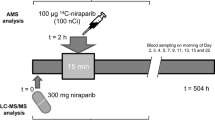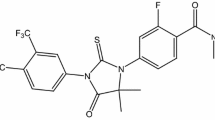Abstract
The effect of probenecid on the pharmacokinetics of diflunisal and its glucuronide and sulphate conjugates was studied in 8 healthy volunteers. Diflunisal 250 mg b. d. was administered p. o. for 15 days and its steady state pharmacokinetics was evaluated on Day 16 after the last dose (control phase). Probenecid 500 mg b. d. was co-administered throughout the entire study period in the treatment phase of the study.
The steady state plasma concentration of diflunisal was significantly higher during the probenecid treatment phase as compared to the control phase (104.0 vs. 63.1 μg·ml−1). This was the result of a significant decrease in the plasma clearance of diflunisal from 5.8 (control) to 3.4 ml·min−1 (probenecid co-administration). The metabolite formation clearances of both glucuronides were significantly decreased by probenecid, -45 % and -54 % for the phenolic and acyl glucuronide, respectively. The metabolite formation clearance of the sulphate conjugate was not affected by probenecid co-administration.
Steady state plasma concentrations of the sulphate and glucuronide conjugates of diflunisal were 2.5- to 3.1-fold higher during probenecid co-administration, due to a significant reduction in the renal clearance of the three diflunisal conjugates. Probenecid also reduced the plasma protein binding of diflunisal, but only to a minor extent; the unbound plasma fraction of diflunisal at steady state averaged between 5 and 30 % higher during probenecid co-administration.
Similar content being viewed by others
References
Beyer KH (1947) New concept of competitive inhibition of the renal tubular excretion of penicillin. Science 105: 94–95
Weiner IM, Washington JA, Mudge GH (1960) On the mechanism of action of probenecid on renal tubular secretion. Bull Johns Hopkins Hosp 106: 333–346
Kampman J, Lindali F, Hansen JM (1973) Effect of probenecid on the excretion of ampicillin in human bile. Br J Pharmacol 47: 782–786
Spahn H, Iwakawa S, Benet LZ, Lin ET (1987) Influence of probenecid on the urinary excretion rates of the diastereomeric benoxaprofen glucuronides. Eur J Drug Metab Pharmacokinet 12: 233–237
Yu T-F, Perel J (1980) Pharmacokinetic and clinical studies of carprofen in gout. J Clin Pharmacol 20: 347–351
Spahn H, Spahn I, Benet LZ (1989) Probenecid-induced changes in the clearance of carprofen enantiomers: a preliminary study. Clin Pharmacol Ther 45: 500–505
Veenendaal JR, Brooks PM, Meffin PJ (1981) Probenecid-clofibrate interaction. Clin Pharmacol Ther 29: 351–358
Duggan DE, Hooke KF, White SD, Noll RM, Stevenson CR (1977) The effects of probenecid upon the individual components of indomethacin elimination. J Pharmacol Exp Ther 201: 463–470
Baber N, Halliday L, Sibeon R, Littler T, Orme MLE (1978) The interaction between indomethacin and probenecid, a clinical and pharmacokinetic study. Clin Pharmacol Ther 34: 298–307
Upton RA, Williams RL, Buskin JN, Jones RM (1982) Effects of probenecid on ketoprofen kinetics. Clin Pharmacol Ther 31: 705–712
Foster RT, Jamali F, Russell AS (1989) Pharmacokinetics of ketoprofen enantiomers in cholecystectomy patients: influence of probenecid. Eur J Clin Pharmacol 37: 589–594
Runkel R, Mroszczak E, Chaplin M, Sevelius H, Segre E (1978) Naproxen-probenecid interaction. Clin Pharmacol Ther 24: 706–713
Smith PC, McDonagh AF, Benet LZ (1985) Effect of probenecid on the formation and elimination of acyl glucuronides: studies with zomepirac. Clin Pharmacol Ther 38: 121–128
Meffin PJ, Zilm DM, Veenendaal JR (1983) A renal mechanism for the clofibrate-probenecid interaction. J Pharmacol Exp Ther 227: 739–742
Abernethy DR, Greenblatt DJ, Ameer B, Shader RI (1985) Probenecid impairment of acetaminophen and lorazepam clearance: direct inhibition of ether glucuronide formation. J Pharmacol Exp Ther 234: 345–349
Kamali F (1993) The effect of probenecid on paracetamol metabolism and pharmacokinetics. Eur J Clin Pharmacol 45: 551–553
Mönig H, Böhm M, Ohnhaus EE, Kirch W (1990) The effects of frusemide and probenecid on the pharmacokinetics of phenprocoumon. Eur J Clin Pharmacol 39: 261–265
Hedaya MA, Elmquist WF, Sawchuk RJ (1990) Probenecid inhibits the metabolic and renal clearances of zidovudine (AZT) in human volunteers. Pharm Res 7: 411–417
Kornhauser DM, Petty BG, Hendrix CW, Woods AS, Nerhood LJ, Bartlett JG, Lietman PS (1989) Probenecid and zidovudine metabolism. Lancet II: 473–475
Miranda P, Good SS, Yarchoan R, Thoam RV, Blum MR, Myers CE, Broder S (1989) Alteration of zidovudine pharmacokinetics by probenecid in patients with AIDS or AIDS-related complex. Clin Pharmacol Ther 46: 494–500
Kamali F, Rawlins MD (1992) Influence of probenecid and paracetamol (acetaminophen) on zidovudine glucuronidation in human liver in vitro. Biopharm Drug Disp 13: 403–409
Tocco DJ, Breault GO, Zacchei AG, Steelman SL, Perrier CV (1975) Physiological disposition and metabolism of 5-(2′,4′difluorophenyl)salicylic acid, a new salicylate. Drug Met Disp 3: 453–466
Loewen GR, Herman RJ, Ross SG, Verbeeck RK (1988) Effect of dose on the glucuronidation and sulphation of diflunisal in man: single dose studies. Br J Clin Pharmacol 26: 31–39
Verbeeck RK, Loewen GR, Macdonald JI, Herman RJ (1990) The effect of multiple dosage on the kinetics of glucuronidation and sulphation of diflunisal in man. Br J Clin Pharmacol 29: 381–389
Cunningham RF, Israeli ZH, Dayton PG (1981) Clinical pharmacokinetics of probenecid. Clin Pharmacokinet 6: 135–151
Vree TB, Van Ewijk-Beneken Kolmer EWJ, Wuis EW, Hekster YA, Broekman MMM (1993) Interindividual variation in the capacity-limited renal glucuronidation of probenecid by humans. Pharm World Sci 15: 197–202
Loewen GR, Macdonald JI, Verbeeck RK (1989) High-performance liquid chromatographic method for the simultaneous quantitation of diflunisal and its glucuronide and sulfate conjugates in human urine. J Pharm Sci 78: 250–255
Dickinson RG, King AR (1989) Reactivity considerations in the analysis of glucuronide and sulfate conjugates of diflunisal. Ther Drug Monit 11: 712–720
Tozer TN, Gambertoglio JG, Furst DE, Avery DS, Holford NHG (1983) Volume shifts and protein binding estimates using equilibrium dialysis: application to prednisolone binding in humans. J Pharm Sci 72: 1442–1446
Houston JB (1982). Drug metabolite kinetics. Pharmacol Ther 15: 521–552
Verbeeck RK (1993). Conjugation reactions in man: studies with diflunisal. In: Jeffery EH (ed) Human drug metabolism. From molecular biology to man. CRC Press, Boca Raton, pp 81–88
Macdonald JI, Dickinson RG, Reid RS, Edom RW, King AR, Verbeeck RK (1991) Identification of a hydroxy metabolite of diflunisal in rat and human urine. Xenobiotica 21: 1521–1533
Dickinson RG, King AR, McKinnon GE, Hooper WD, Eadie MJ, Herkes GK (1993) Studies on the renal excretion of the acyl glucuronide, phenolic glucuronide and sulphate conjugates of diflunisal. Br J Clin Pharmacol 35: 609–613
Verbeeck RK, Dickinson RG, Pond SM (1988) Biliary excretion of diflunisal conjugates in patients with T-tube drainage. Eur J Clin Pharmacol 34: 423–426
Verbeeck RK, Boel A, Buntinx A, De Schepper PJ (1980) Plasma protein binding and interaction studies with diflunisal, a new salicylate analgesic. Biochem Pharmacol 29: 571–576
Sorgel F, Beyhl FE, Mutschler E (1979) Inhibition of uridine diphosphate glucuronyl transferase caused by probenecid. Experientia 36: 861–863
Dickinson RG, Verbeeck RK, King AR, Restifo AC, Pond SM. Diflunisal and its conjugates in patients with renal failure. Br J Clin Pharmacol 31: 546–550
Vree TB, Van den Biggelaar-Martea M, Van Ewijk-Beneken Kolmer EWJ, Hekster YA (1993) Probenecid inhibits the renal clearance and renal glucuronidation of nalidixic acid. Pharm World Sci 15: 165–170
Vree TB, Van den Biggelaar-Martea M, Verey-van Wissen CPWGM, Van Ewijk-Beneken Kolmer EWJ (1994) Probenecid inhibits the renal glucuronidation of indomethacin and Odesmethyl-indomethacin in humans. Pharm World Sci 16: 22–26
Author information
Authors and Affiliations
Rights and permissions
About this article
Cite this article
Verbeeck, R.K., Macdonald, J.I., Wallace, S.M. et al. Effect of probenecid on the formation and elimination kinetics of the sulphate and glucuronide conjugates of diflunisal. Eur J Clin Pharmacol 47, 519–523 (1995). https://doi.org/10.1007/BF00193705
Received:
Accepted:
Issue Date:
DOI: https://doi.org/10.1007/BF00193705




